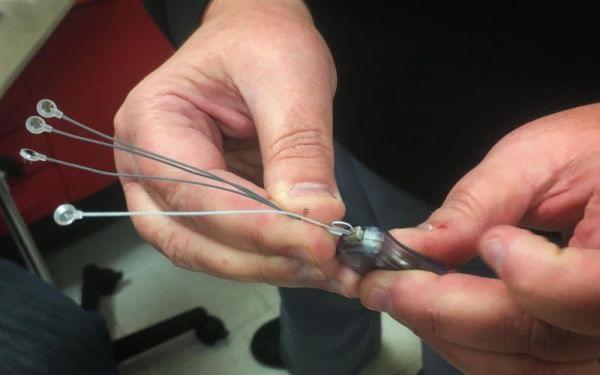Alaska Plans To Spend Government Funds On Indiana-Made Addiction Treatment Device

The Bridge device, which is supposed to help with opioid withdrawals, is made in Indiana. Jake Harper/Side Effects Public Media
Alaska plans to use federal grant money to purchase a controversial device used in opioid addiction treatment.
Last week, the Alaska Department of Labor and Workforce Development announced it will use part of a $1.3 million federal grant to purchase the Bridge device, which is made in Indiana. The Bridge is a nerve stimulator that attaches around a patient’s ear to reduce nausea, aches and other symptoms associated with opioid withdrawal.
But addiction experts argue the device has not been properly studied, and that states should put resources toward more proven therapies, such as medications that are used to treat opioid withdrawals and addiction.
“It’s a stupid policy decision,” said Basia Andraka-Christou, a professor at University of Central Florida who studies addiction policy. “You're taking taxpayer money and spending it on a treatment that, even though it's FDA cleared, doesn’t have a strong evidence base.”
The Bridge and Innovative Health Solutions, the device maker, have come under scrutiny in recent months. In May, a Side Effects Public Media and NPR investigation found that the study examining the device’s use in opioid withdrawals skirted federal Food and Drug Administration guidelines and ethical norms in research. The study lacked appropriate oversight to ensure both patient safety and the validity of the data being gathered, and patients were unaware they were involved in research.
The FDA based its clearance of the device in November 2017 on that study. Both the FDA and the American Journal of Drug and Alcohol Abuse, which published the study in March 2017, said they are currently reviewing the research.
However, addiction experts were critical of the evidence supporting the Bridge even before the Side Effects/NPR story was published. The single study is too limited, they argue, and does not eliminate the possibility of the placebo effect, which occurs when a patient believes an intervention works.
The company’s marketing efforts and provider enthusiasm have fueled interest in the device across the country.
Shawna Harper, a program coordinator with the Alaska Department of Labor and Workforce Development, said the department learned of the device’s potential through addiction treatment providers in the state. The state plans to monitor patients who receive the device to measure their long-term success in finding and maintaining employment. The department will set aside approximately $100,000 for the device and related services.
“What we’ve seen firsthand really made us more of a believer,” said Harper. She said the department was aware of the limited scientific evidence behind the Bridge. “Even if it is a placebo effect, if the outcomes are the same, that's a good deal.”
Critics, however, argue that, at $595 per device, other withdrawal treatment options are more cost effective than the Bridge.
“It’s probably not the thing I’d be funding right away,” said Dr. Dan Rusyniak, a professor at the Indiana University School of Medicine who has focused on drug abuse. “There are certainly other ways to treat withdrawals.”
For instance, clonidine, a blood pressure and anxiety medication, has been used for years to help reduce withdrawal symptoms, and the FDA recently approved lofexivide, which is chemically similar to clonidine, expressly to treat opioid withdrawals. Buprenorphine and methadone, both long-acting opioids, are used to reduce withdrawal symptoms and cravings for illicit opioids like heroin or fentanyl.
“I don't even know that this [device] has been compared to the way we treat withdrawal currently,” Rusyniak said.
Innovative Health Solutions president Brian Carrico said there were research efforts underway to bolster the evidence behind the Bridge, but he declined to provide details. A search on ClinicalTrials.gov, where researchers register clinical trials, did not show any studies to examine the Bridge in opioid withdrawals.
Pressed for more information on the studies, Carrico said, “I’ll check with our counsel and will get back to you.”
The Alaska Department of Labor and Workforce Development plans to partner with Mat-Su Regional Medical Center and North Country Medical to use the device on patients with opioid addiction. North Country Medical was involved in the study published last year that is now under scrutiny from the FDA and the American Journal of Drug and Alcohol Abuse.
While Harper was aware of the limited evidence for the device, she said she did not know of the ethical issues raised in the NPR/Side Effects investigation. After Side Effects sent the article to her, she and a spokesperson did not respond to requests for further comment.
Harper said the department intended to finalize the proposal to spend federal money on the devices this week.
This story was produced by Side Effects Public Media, a news collaborative covering public health.
Links
- Why A Gap In Addiction Treatment Persists Despite A National Decline In Opioid Prescriptions
- An Opioid Prescription In Illinois Could Be A Ticket For Medical Marijuana
- How One Woman Escaped Sex Trafficking And Overcame Her Opioid Addiction
- Questions Raised About Study Of Device To Ease Opioid Withdrawal
- As States Embrace Cannabis As Opioid Alternative, Science Lags Behind Policy

